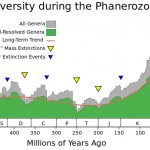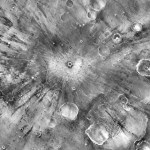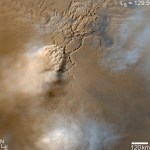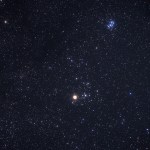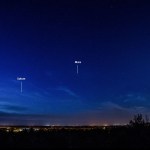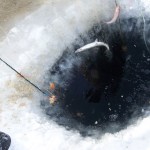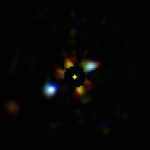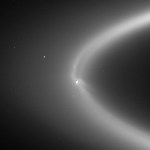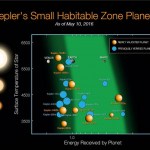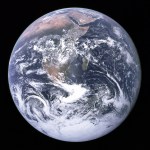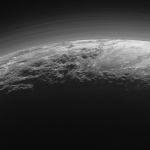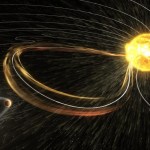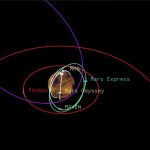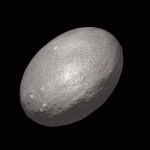Solar System
"That which can be asserted without evidence, can be dismissed without evidence." -Christopher Hitchens
65 million years ago, a catastrophic impact from outer space caused the last great mass extinction on Earth, destroying 30% of the species that lived on our world at the time. These mass extinction events happened many times in Earth’s past, and the Solar System also passes through denser stellar regions of space periodically, as determined by the orbit of the Sun and stars in the Milky Way.
Every 31 million years or so, the Sun moves through the galactic plane, crossing over the region of…
"Although we were initially quite skeptical that this planet could exist, as we continued to investigate its orbit and what it would mean for the outer solar system, we become increasingly convinced that it is out there." -Konstantin Batygin
Last year, scientists Konstantin Batygin and Mike Brown made a huge splash when they announced that the Solar System likely contained a super-Earth-sized object beyond the orbit of Neptune. They dubbed the world ‘Planet Nine,’ and claimed that it was responsible for the orbits of the longest-period Trans-Neptunian Objects ever discovered. The fact…
"There is, then, no water that is wholly of the Pacific, or wholly of the Atlantic, or of the Indian or the Antarctic. The surf that we find exhilarating at Virginia Beach or at La Jolla today may have lapped at the base of antarctic icebergs or sparkled in the Mediterranean sun, years ago, before it moved through dark and unseen waterways to the place we find it now. It is by the deep, hidden currents that the oceans are made one." -Rachel Carson
Later this year, one of the most epic Earth-monitoring missions of all time, the NASA/NOAA collaboration JPSS-1, will launch. With a suite of five…
"This would be like an F8 tornado sweeping across the surface. These are winds on Mars that will never be seen again unless [there is] another impact." -Peter Schultz
When you examine craters on the surfaces of worlds across the solar system, you find that there are rays emanating outward, containing a mix of ejecta from the impactor and the surface itself. But there’s a limit to how far those rays go, and that’s normally dependent on the size of the crater. In a few instances on Mars, however, those rays go much, much farther than physics would indicate.
A detailed, infrared view of a…
"People who work every day are kind of scared of things they don't understand." -Young Jeezy
From Mercury out to Neptune, most of the worlds in the Solar System have moons, with a hitherto discovered population of around 200 known ones. Yet despite all of it, we don’t know of a single instance of a moon that has its own natural satellite: a moon with a moon of its own. But that doesn’t mean it couldn’t exist!
The major moons in our Solar System could contain some objects with candidates for potentially having orbiting moons of their own. If many of these moons were situated differently,…
"They say once you grow crops somewhere, you have officially 'colonized' it. So technically, I colonized Mars. In your face, Neil Armstrong!" -Andy Weir
In the early 1960s, humanity began launching spacecraft to Mars, hoping to find out what the red planet was truly like. While early images revealed a heavily cratered surface, similar to that of the Moon, that turned out to be reflective of only a portion of the surface. Mars contains dust storms, basins, extinct volcanoes and the largest chasm of any planet in the Solar System.
A dust storm on Mars, a common occurrence during the Martian…
“Finding out that something you have just discovered is considered all but impossible is one of the joys of science.” -Mike Brown
In January of last year, astronomers Konstantin Batygin and Mike Brown shocked the world by proposing that there was a world larger than Earth located some five-to-ten times as distant as Neptune. That this world — known as Planet Nine — was causing the ultra-distant Kuiper belt objects we'd discovered so far to all have predicable, peculiar properties. And the observations matched up really well.
The 3D orbits of the Kuiper belt objects influenced by Planet Nine…
"I long ago abandoned the notion of a life without storms, or a world without dry and killing seasons. Life is too complicated, too constantly changing, to be anything but what it is. And I am, by nature, too mercurial to be anything but deeply wary of the grave unnaturalness involved in any attempt to exert too much control over essentially uncontrollable forces." -Kay Redfield Jamison
Under ideal conditions, Mercury achieves a maximum elongation, or angular separation, from the Sun of 28 degrees. Total darkness is achieved when the Sun dips 18 degrees below the horizon. So for many of us,…
"A few centuries ago, the pioneer navigators learnt the size and shape of our Earth, and the layout of the continents. We are now just learning the dimensions and ingredients of our entire cosmos, and can at last make some sense of our cosmic habitat." -Martin Rees
You might think that Jupiter is the largest planet in the Solar System because it’s the most massive, but that’s not quite right. If you kept adding mass to Saturn, it would get larger in size, but if you kept adding mass to Jupiter, it would shrink! For a given set of elements that your planet is made out of, there’s a maximum…
“There is a fine line between censorship and good taste and moral responsibility.” -Stephen Spielberg
Another week full of amazing science stories has gone by here at Starts With A Bang, and there are some fun and fantastic announcements! We welcomed a new contributor, Jess Shanahan, to our ranks; I found out that Forbes has made me their official Star Trek: Discovery reviewer when that new series premieres; I'm in the process of selecting the final, officially licensed images for my new book, Treknology (and pre-order today!); and from this coming Thursday through Sunday, I'll be the Science…
"Resources exist to be consumed. And consumed they will be, if not by this generation then by some future. By what right does this forgotten future seek to deny us our birthright?" -Sid Meier's Alpha Centauri
The dream of humanity has long been to identify an inhabited world beyond Earth, to know for certain that life is not unique to our pale blue dot. If we were located a great distance away, there are observations of Earth we could make that would tell us a tremendous amount of information about our world, including about its oceans, clouds, continents, the "greening" of our…
"Aha! That satellite was scuttled on Enceladus, Saturn's main dump moon!" -Professor Farnsworth, Futurama
When you think about life beyond Earth, you likely think of it occurring on a somewhat Earth-like planet. A rocky world, with either a past or present liquid ocean atop the surface, seems ideal. But that might not even be where life on Earth originated! Deep beneath the Earth’s surface, geologically active hydrothermal vents currently support diverse colonies of life without any energy from the Sun. Saturn’s icy moon, Enceladus, has a subsurface ocean unlike any other world we’ve yet…
"You can spend too much time wondering which of identical twins is the more alike." -Robert Brault
When we think of the idea of “Earth’s twin,” we inevitably think of a planet like ours orbiting a star like ours at the same distance and speed. Most planets are not rocky and Earth-sized; most stars are not like the Sun; most planetary orbits don’t have Earth’s orbital parameters. Yet the idea that a twin of our planet is out there, and that’s the most likely place to look for life, persists.
Although many of the Earth-like candidates from Kepler are close to Earth in physical size, they…
"I put up my thumb and shut one eye, and my thumb blotted out the planet Earth. I didn't feel like a giant. I felt very, very small." -Neil Armstrong
The full Moon is undoubtedly bright. As viewed from the Earth’s surface, it’s the second brightest object of all, after the Sun, and is more than 1,500 times brighter than Venus. In fact, the full Moon is over 40 times brighter than the entire rest of the night sky combined, and can outshine even a big city when seen right next to one.
The rising full Moon and the city of Chicago, as viewed over Lake Michigan from Northwestern University's…
"One should not need a teleportation device to decide whether a newly discovered object is a planet." -Jean-Luc Margot
It was a harsh lesson in astronomy for all of us in 2006, when the International Astronomical Union released their official definition of a planet. While the innermost eight planets made the cut, Pluto did not. But given the discovery of large numbers of worlds in the Kuiper belt and beyond our Solar System, it became clear that we needed something even more than what the IAU gave us.
This diagram compares the sizes of the newly-discovered planets around the faint red star…
"Mars' atmosphere is so thin, you do not need a lot of streamlining. By the time the ship is going fast enough for air resistance to matter, it'll be high enough that there will be practically no air." -Andy Weir, The Martian, as spoken by Bruce Ng
If you had taken a trip to our Solar System four billion years ago, you would have found two worlds with liquid water oceans, temperate atmospheres and all the conditions we believe are needed for life. Earth would have been one of them, but Mars would have met all those criteria, too.
A solar storm, which creates aurorae here on Earth, would…
"If we get rid of the moon, women, those menstrual cycles are governed by the moon, will not get PMS. They will stop bitching and whining." -Joe Scarborough, misattributing a quote to Arnold Schwarzenegger that was actually spoken by an impersonator
Our Moon is pretty unusual as far as the Solar System goes: of all the planets, our Moon has the largest mass and radius ratios when compared to its parent planet. It’s enough to not only illuminate our night sky quite fiercely -- the full Moon is 14,000 times brighter than the next brightest object in the night sky -- but it has some significant…
"The larger inner moons fall back to Mars after about 5 million years due to the tidal pull of the planet, after which the two outer satellites evolve into Phobos- and Deimos-like orbits." -Pascal Rosenblatt, et al.
Compared to the other moons we know of in the Solar System, Mars’s two, Phobos and Deimos, are incredibly difficult to explain. They look like captured asteroids, being small, irregular, and exhibiting the right surface features. But captured asteroids form inclined or even retrograde orbits quite distant from their planet, while Phobos and Deimos live in circular,…
"How vast those Orbs must be, and how inconsiderable this Earth, the Theatre upon which all our mighty Designs, all our Navigations, and all our Wars are transacted, is when compared to them." -Christiaan Huygens
It was quite a surprise when we started discovering all the exoplanets that were out there. While there’s a big gap between a world like Earth and a world like Uranus or Neptune in our Solar System – 17 times the mass and 4 times the radius – most of the worlds out there fall in between these two types. Super-Earths and Mini-Neptunes are the most common.
The numbers of planets…
"'I'll follow him to the ends of the earth,' she sobbed. Yes, darling. But the earth doesn't have any ends." -Tom Robbins
We have some pretty good definitions of what it takes to be a planet, and one part of that definition is that a world needs to be massive enough to pull itself into hydrostatic equilibrium. In the absence of external forces and rotation, that means it will be a perfect sphere.
The line for a planet vs. a non-planet is mass-dependent, and making a thin, rigid body fails on that account. You can have a flat "thing" in space, but it wouldn't be a planet if you did. Image…
